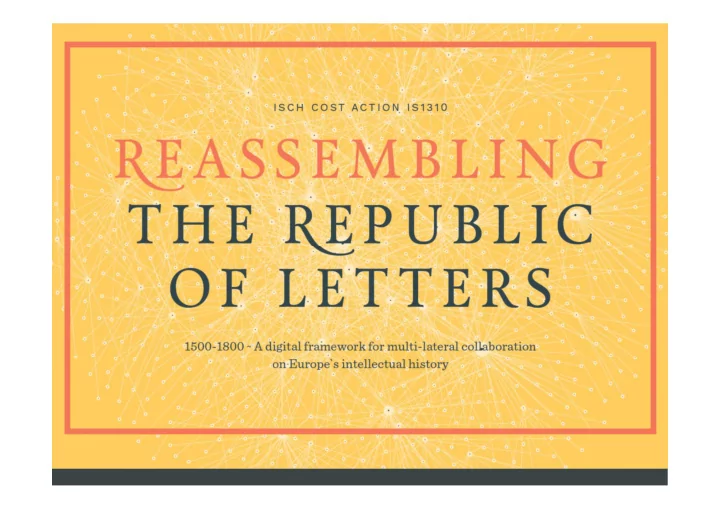

WG2 Workshop: Basic questions What is the context? Background: Howard Hotson • Why do we need it? • Research Questions: Robin Bunig, Thomas Wallnig How should it be structured? • Data model: Mikkel Jensen. Jetze Touber How do we get data into it and link it together? • Eetu Mäkelä, Jouni Tuominen, Antske Fokken What do we get back out of it? • Data analysis and visualisation: Martin Hadley, Sandra Toffolo Where do we go from here? • CofK / EMLO, COST RRL, H 2020, spinoff applications
Between 1500 and 1800, the evolution of postal communication allowed ordinary men and women to scatter letters across and beyond Europe.
This exchange helped knit together what contemporaries called the respublica litteraria , a knowledge-based civil society, crucial to that era’s intellectual breakthroughs.
Yet the exchange of letters which created this community also dispersed the documentation required to study it, posing enormous difficulties for historians ever since. Pier-Francescao Mola (c.1647-57) :Victoria and Albert Museum
To reassemble that scattered material and chart the history of that imagined community, we need to harness the ongoing revolution in digital communications.
As the advantages of digital technology for this field have become apparent in recent years, web-based projects on early modern correspondence have proliferated.
To reassemble the scattered data on this community, we now need a revolution in digital communications, based on collaboratively developed standards and infrastructure.
Why do we need it? Research Questions Gottfried Wilhelm Leibniz (1646-1716)
Leibniz’s network A static view http://www.gwlb.de/Leibniz/Leibnizarchiv/Korrespondenz/
Leibniz’s network A dynamic view A Heinekamp and I Hein , A Heinekamp and I Hein , Leibniz und Europa (1994) Leibniz und Europa (1994)
Leibniz’s network A genetic view Gregory Brown, University of Houston, 2005 A Heinekamp and I Hein , Leibniz und Europa (1994)
Leibniz’s network People, places and topics A Heinekamp and I Hein , Leibniz und Europa (1994)
WG2 Workshop: Basic features Definition What do we mean by ‘prosopography’? = Biographical data in structured form Purpose Why do we need it? What are we aiming for? Task Requisites disambiguating people basic data understanding networks location and contact histories understanding content rich biographical information a generic tool standard solutions
WG2 Workshop: Basic features Basic approach A dynamic model: based on event streams rather than attributes (every attribute has its history: Leibniz was not born a mathematician, etc.) Balance The greatest difficulty will be to find a balance between Simplicity (easy to learn) Comprehensiveness (covers many cases) User-friendliness (easy to use) Durability (not requiring revision) Flexiblility (adaptable to many purposes) Possible starting point Academics: i.e. the species of intellectuals with the most regular and best documented careers
How should it be structured? Data model Pilot projets
Prosopographical data model Basic categories genealogy personal life social status personal location history social contact ecclesiastical activities educational activities professional activity learned activities creative work activity
Prosopographical data model Basic categories genealogy personal life social status personal location history social contact ecclesiastical activities educational activities professional activity learned activities creative work activity
Prosopographical data model ‘Educational activities’
Prosopographical data model ‘Matriculation’
How do we get data into it? Data inputting Spreadsheet
Data inputting Webform
Data inputting Semi-automation
What do we get out of it? Data output typical entry 1599-05-10 matriculation, Paedagogium, Herborn 1600-10-08 in third class, Paedagogium, Herborn 1602-10-02 matriculation, schola publica, Herborn 1605 theological disputation under Johannes Piscator 1605 verses in disputation by Joannes Vetterus 1606-04-29 matriculation, University of Marburg 1606-late travelled to Westphalia 1607-07 matriculation, University of Basel studied mathematics under Leonhardt Zubler 1608 Published Flores theologici , Basel 1608-10-10 letter from Caspar Waser, Basel
WG2 Workshop: Basic questions What is the context? Background: Howard Hotson • Why do we need it? • Research Questions: Robin Bunig, Thomas Wallnig How should it be structured? • Data model: Mikkel Jensen. Jetze Touber How do we get data into it and link it together? • Eetu Mäkelä, Jouni Tuominen, Antske Fokken What do we get back out of it? • Data analysis and visualisation (Martin Hadley, Sandra Toffolo) Where do we go from here? • CofK / EMLO, COST RRL, H 2020, spinoff applications
http://www.republicofletters.net http://www.culturesofknowledge.org/ http://emlo.bodleian.ox.ac.uk/
Recommend
More recommend